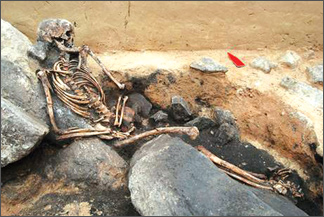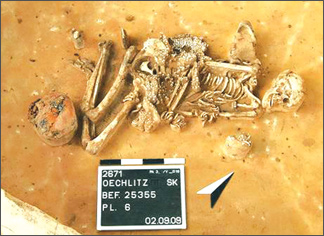[‘Extraordinary’ ancient skeletons found]
 This ‘extraordinary’ skeleton of a woman buried in a seated position
was discovered during an archaeological survey before the planned
construction of a high-speed train track in central Germany, scientists
said in a statement. The woman, who lived in the early Bronze Age
(roughly 2200 to 1600 B.C.), was found near the town of Bad Lauchstadt
and is one of several burials found so far during the dig, which runs
from September 2008 to June 2010. This ‘extraordinary’ skeleton of a woman buried in a seated position
was discovered during an archaeological survey before the planned
construction of a high-speed train track in central Germany, scientists
said in a statement. The woman, who lived in the early Bronze Age
(roughly 2200 to 1600 B.C.), was found near the town of Bad Lauchstadt
and is one of several burials found so far during the dig, which runs
from September 2008 to June 2010.
“From an archaeological point of view, the excavation is a great
chance to learn about the development of settlement on the Querfurter
Platte”, a geological plate between the Saale and Unstrut river valleys,
according to Ralf Bockmann, a spokesperson for the Saxony-Anhalt Office
for Monument Protection and Archaeology in Saale, Germany, via email.
For example, according to the statement, “the broad range of traces
from ancient cultures and the number and quality of the individual finds
show how important this region has been for thousands of years not just
as a settlement area, but as a transport route”. Bockman added, “The
region has fertile soils and has been used for settlement for a very
long time. But until now there had been no large-scale excavations in
that region”.
 An early Bronze Age woman is buried with decorative shell beads in
the town of Oechlitz, one of several burials found during an ongoing
archaeological dig in central Germany, experts said in October 2009. In
addition to the small shell discs, worn as decoration on clothing,
copper and amber jewelry with hundreds of dog teeth have been found in
the burials, which span several thousand years, according to a statement
from the Saxony-Anhalt Office for Monument Protection and Archaeology,
translated into English by Spiegel Online. An early Bronze Age woman is buried with decorative shell beads in
the town of Oechlitz, one of several burials found during an ongoing
archaeological dig in central Germany, experts said in October 2009. In
addition to the small shell discs, worn as decoration on clothing,
copper and amber jewelry with hundreds of dog teeth have been found in
the burials, which span several thousand years, according to a statement
from the Saxony-Anhalt Office for Monument Protection and Archaeology,
translated into English by Spiegel Online.
Ornaments such as shell beads are among the first signs of the shift
to modern human behavior, which occurred at least 82,000 years ago,
previous research suggests.
 A Slavic graveyard in the town of Oechlitz from the ninth or tenth
centuries A.D. is one of the more recent discoveries made during the
dig, which is the largest of its kind in Germany, according to Spiegel
Online. A Slavic graveyard in the town of Oechlitz from the ninth or tenth
centuries A.D. is one of the more recent discoveries made during the
dig, which is the largest of its kind in Germany, according to Spiegel
Online.
“Even though the bodies were laid with the head pointed west
according to the Christian tradition”, the presence of food remains and
containers, evidence that physical sustenance was provided for the
afterlife, “indicate that heathen traditions were also observed in
furnishing the dead”, according to a statement from the Saxony-Anhalt
Office for Monument Protection and Archaeology, translated into English
by Spiegel.
-National Geography
|



